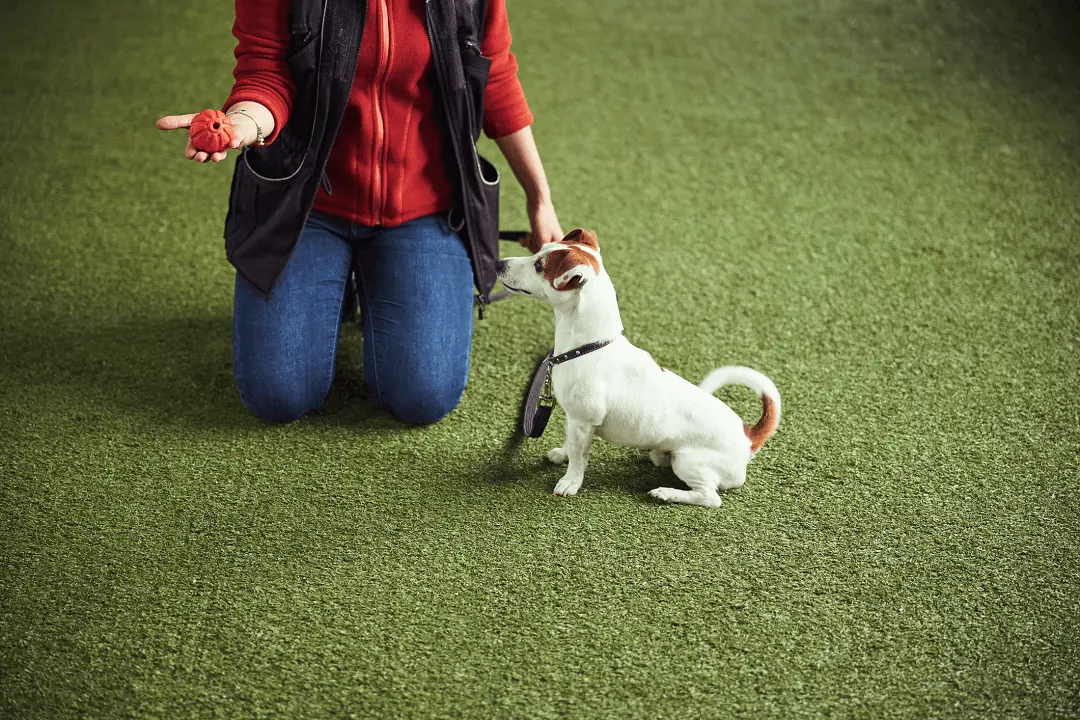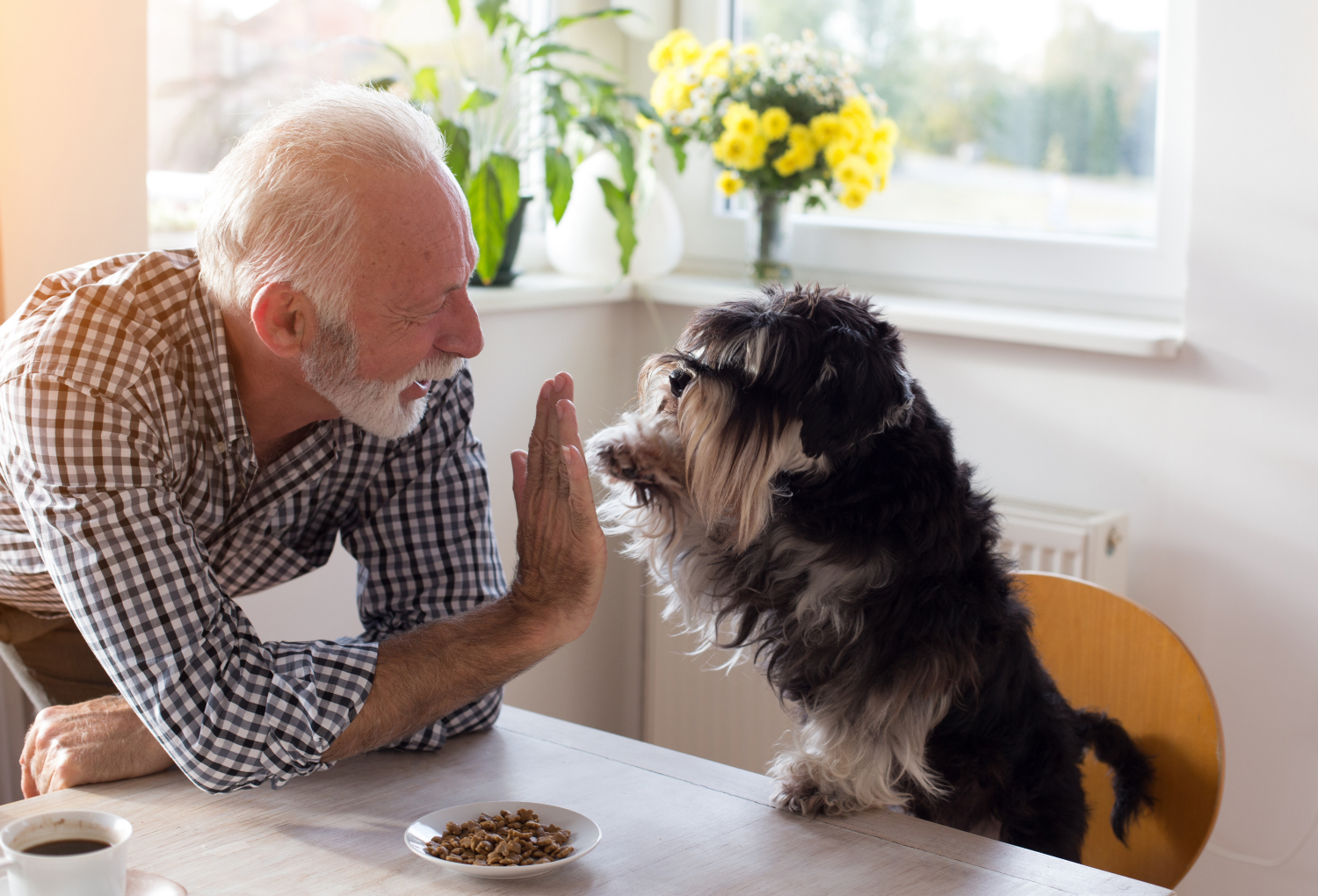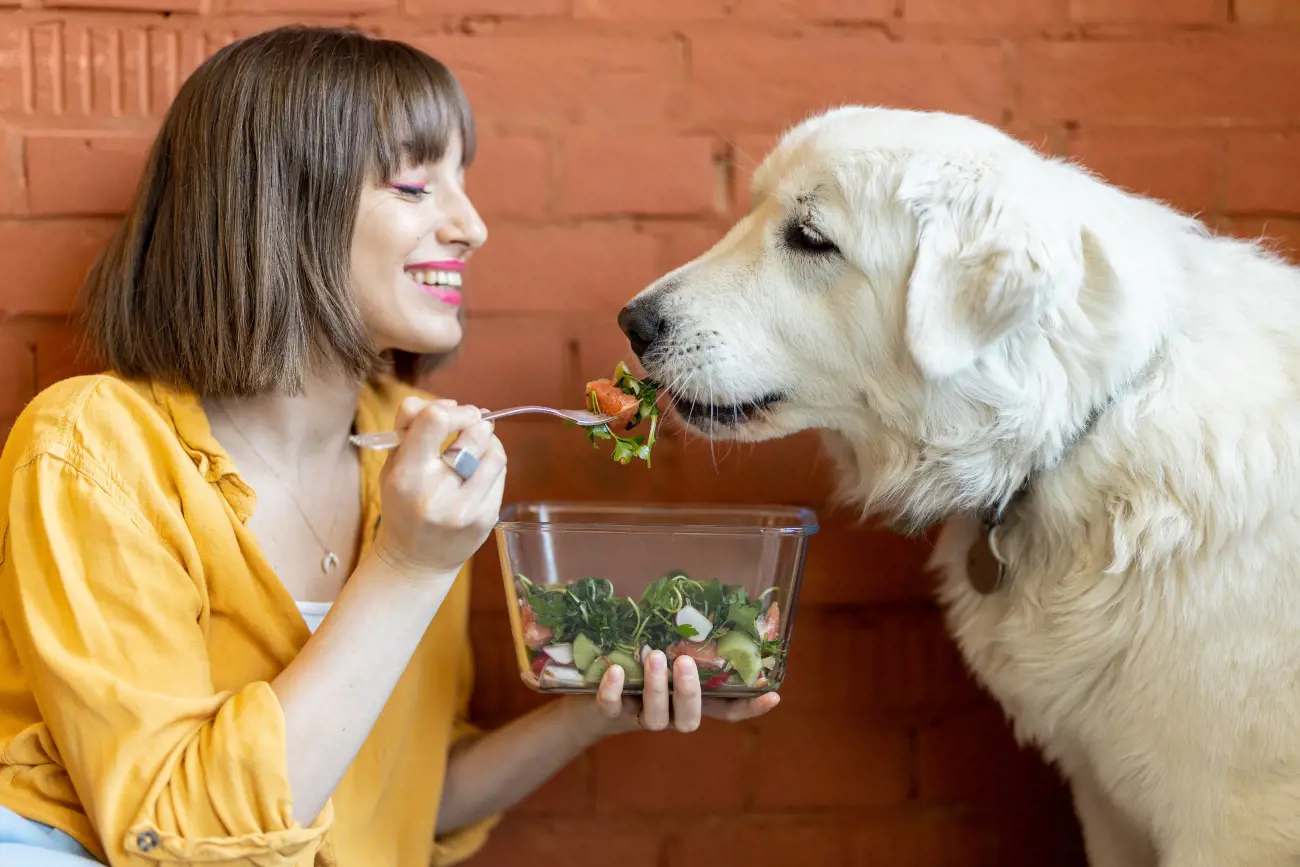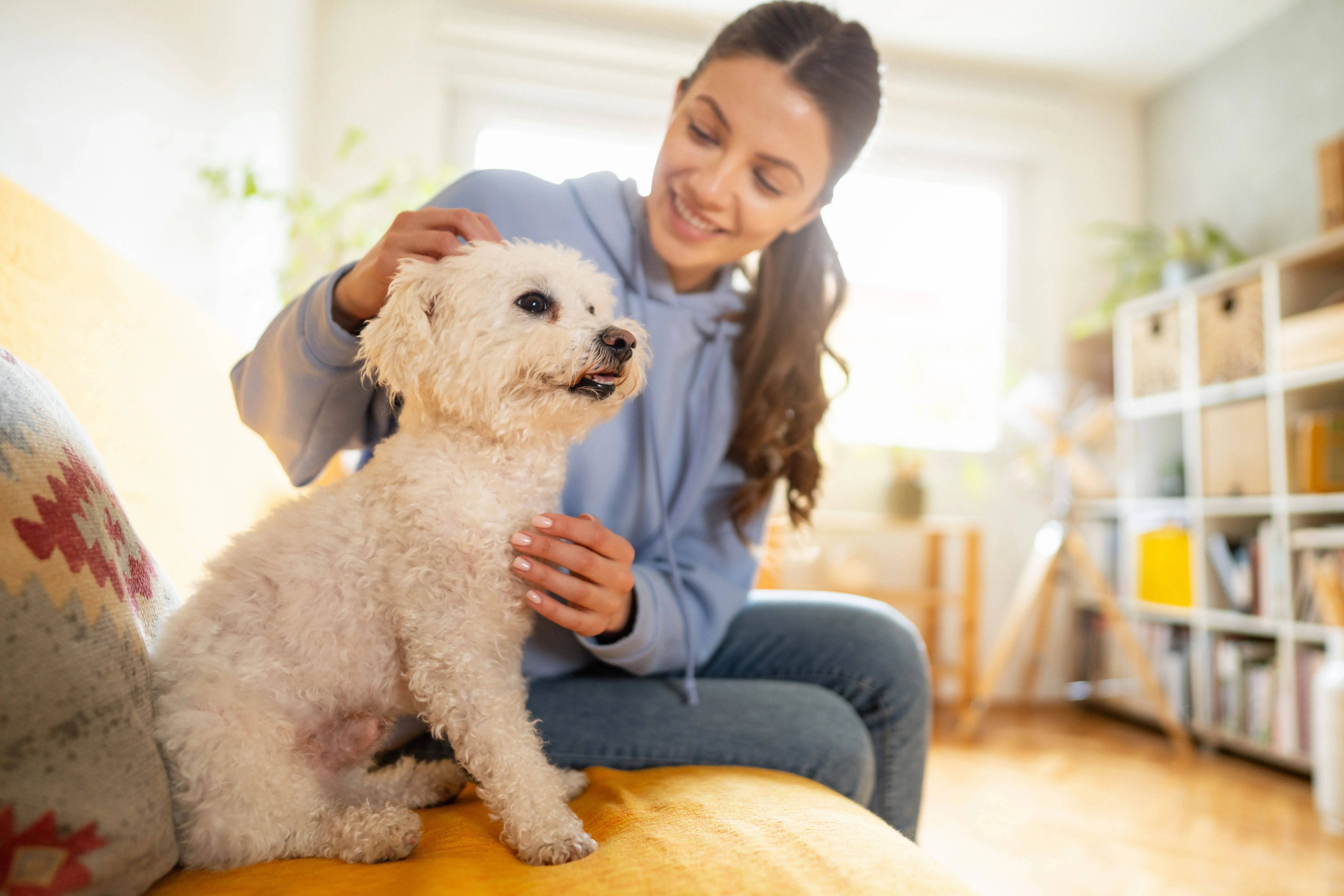Dog training 101 – the essential guide to teaching your pet new skills
19th January, 2023

Training your dog is the perfect way to teach obedience while building a bond between you. Not sure where to start? Our dog training guide will show you how.
Whether it’s an adorable puppy or fully grown adult, bringing a dog home is an exciting time for everyone in the family.
The novelty can soon wear off, though, if they start gnawing through all your favourite socks or marking their territory on your sofa.
So, how can you keep them in check and avoid any unwanted behaviours?
By training them from the get-go. With just a few basic commands, you and your canine companion can avoid behaviour battles and enjoy each other’s company for years to come.
Watching your pup learn new skills and obey your commands is a rewarding part of being a pet parent. It’s also a wonderful way for the two of you to bond and build trust.
When you get a new four-legged friend, training should be one of your priorities, along with buying everything it needs and finding to protect it in emergencies.
If you’re stuck for training ideas or not sure where to start, read on. We share why it’s important to teach your dog good behaviour and give you some expert tips from Clinical Animal Behaviourist Rosie Bescoby.
What is dog training and its benefits?
Training a dog involves teaching it new skills and behaviours. Your pet will learn to react to various commands and gestures as well as adapt the way they act in different situations.
Rewarding your canine companion when they do something well is important to let them know they did a good job and to encourage them to do the same again.
Dog training has a host of benefits, and it’s well worth the effort for any new pet parent out there – just like finding the right dog insurance lifetime cover.
Here are some of the reasons why you should teach dogs, young and old, new tricks:
- It forms a stronger bond – You and your pet will likely spend many hours together to perfect these new skills, which helps build trust and love between you.
- You can enjoy your time outdoors more – Walkies will be much more fun for you both when you know your dog will come when called and they know they can have more freedom when they’re obedient.
- They get plenty of stimulation – Canines are intelligent beings and can get bored Training gives them both mental and physical stimulation and learning is also something they love.
- It keeps your house clean – One of the first skills most owners teach their pets is where to go to the toilet. After all, no one enjoys cleaning up a mess indoors, and it can also begin to smell very quickly! You can also teach your pet to sit and wait while you clean muddy paws.
- They’ll make more friends – If your dog knows how to interact with other animals and people, they’ll get along with them much better. It could also help you avoid having to claim on your dog insurance, lifetime cover for any third party injuries.
How do I begin training my dog?
Before you start teaching your new puppy to bring you the newspaper or wake the kids up, they need to learn the basics. So what are the simplest skills to learn?
- Come
- Lie down
- Heel
- Sit
- Stay
- Drop
When teaching your four-legged family member new commands, there are a few golden rules you should follow to get the best results.
- Keep distractions to a minimum.
- Divide the training into short but regular sessions.
- Be patient – not all dogs learn fast, so don’t worry if they don’t pick something up immediately.
- Reward good behaviour. Most specialists agree that positive reinforcement is the most effective method for both dog and owner.
- End each session with a skill your pet knows to finish on a positive note and keep them happy.
- Enjoy yourselves and have fun.
Remember, even the most obedient dogs can become distracted and get into trouble. However well-behaved you think your pet is, dog insurance with lifetime cover will be invaluable if they get injured in an emergency.
If your canine companion gets into an accident or becomes suddenly ill, you might be faced with large and unexpected vet bills. An insurance policy can help you pay for treatment and care to help your dog get back to their normal self.
Basic dog skills training
You’ve read the benefits and you’re ready to get started with your new pet. Remember to stay patient and have plenty of treats and cuddles ready to reward your dog when they do well.
Follow these steps from Clinical Animal Behaviourist Rosie Bescoby to teach your dog to lie down:
- Ask your pet to sit and then hold a treat at the end of their nose. Slowly move it down to the floor between your dog's paws so they have to lie down to get it. If they stand up, start again.
- Let them eat the treat and give lots of praise when they lie down.
- Repeat the process without a treat in your hand and add a verbal cue like ‘down’ as you move your hand towards the floor. Give plenty of praise again when they do it properly.
- When your dog responds to the verbal and hand signal, make the hand signal more subtle. You can use it as a back-up if they don’t respond to the verbal cue.
Be consistent and repeat the process lots of times until your dog has mastered this skill. You can use the same method for teaching other basic commands.
House and crate training
Stepping into a wet puddle is no fun at all, so one of the first things you need to teach your dog is where to go to the toilet.
Crates can be very helpful in the process and also provide a ‘safe space’ for your furry family member to retreat to when they need some down time.
House training
Both playful puppies and golden oldies can be housetrained, but it takes longer the older they are. Patience and consistency are key to success.
Here are a few tips to help your new hound learn to use the toilet outdoors rather than go on your carpet.
- Anticipate the act. Small puppies can only hold it in for 3-4 hours, so make sure you’re taking them out frequently. Adult dogs can wait up to 8 hours, but as they age, they might need to go out more often again.
- Choose a loo location. Take your pet to the same spot every time. This can be indoors on a training pad, a doggy litter box, or a chosen outdoor space.
- Keep it on a lead. If you take your pup outdoors to do its business, don’t let it off the lead until it’s done. If you set them free before they use the loo, they might just play and then wee when they come indoors.
- Reward the deed. When your dog goes to the toilet, give them lots of praise.
- Confine in a crate. If your pet doesn’t do its business outdoors, confine them in a crate for 15 minutes. This way, if they then do their business, it’ll be easy to clean.
- Look for clues. If you see your dog sniffing the floor and walking in circles, they might be getting ready to do a poo. Let them out to their designated spot and give lots of praise when they go in the right area.
- Eliminate the evidence. If your pup does go indoors (they may well do the first few times), clean the area and neutralise the odour so they don’t get lured to the same spot.
One thing you should never do when house training your four-legged friend is to get angry when they have an accident. If you do, your dog will associate the process with punishment and try to hide their toilet habits from you and go when you’re not looking.
They might also start to hold it in, which can cause more serious health issues. These could see you claiming on your dog insurance, lifetime cover when they need emergency care.
Crate training
Your dog’s crate should become a positive space where it wants to be and must never be used for punishment or to keep it in for extended periods. Make sure your crate is:
- Made from durable, top-quality materials
- Easy to transport
- Quick and simple to clean
Put a soft bed in the bottom of the crate and a few of your pet’s toys. Throw a few treats inside to encourage your dog to enter and let it explore. Leave the door open and give plenty of praise when they go in and out by themself.
Over time, the crate will become somewhere your canine companion wants to be and where they’re happy to be left alone to walk in and out of for a few hours.
Training your dog to be home alone
It’s impossible to be with your dog 24 hours a day, so you’ll need to train them to be well-behaved and stay happy while you’re away.
Many canines suffer from separation anxiety, especially when they are still settling into their new home. How can you tell your pet is experiencing this?
- They chew things they shouldn’t.
- Neighbours complain of barking, or you hear it when you leave and return home.
- They go to the toilet on the floor even though they’re trained not to.
So, what can you do to help your pet and make sure they’re happy to be left for a few hours? Rosie Bescoby says you first need to establish the cause.
Your pet might be feeling scared, not getting enough stimulation, or you’re leaving them alone for too long. According to Rosie, canines should never be left for more than 4 hours at a time.
To help them cope by itself, teach your dog to settle when you’re still at home. Help them relax in their bed and give them a treat for being well-behaved. You can use a baby gate to establish a barrier between the two of you.
Build up the amount of time you leave them alone while you’re still at home and then start to do the same when you go out of the house. Rosie suggests using a dog appeasing pheromone to help them feel safe.
If you’re still having trouble after extensive training, speak to your vet for further help.
Walking training
Every dog needs to go out on a daily walk or two. Without training, your canine companion’s natural instincts can kick in, and you might find them peeing on someone’s handbag or getting overly friendly with another pooch.
Teaching them to behave both on and off the lead is important and can save you some embarrassment while out and about!
You’ll need a flat collar or harness that isn’t too tight to make walks comfortable and enjoyable for your dog.
Rosie Bescoby says the aim is to walk your dog on a loose lead next to you. Stop walking if the lead goes tense and they will quickly learn that they can only continue when the lead is loose.
Once you let them off the lead, you need them to come back whenever you call them. This can stop them getting into sticky situations or scrapping with other dogs – two situations where you might have to claim on your dog insurance, lifetime cover.
Reward them every time they engage with you, so when they choose to walk by your side or come back and check-in from time to time.
Keep the training sessions fun and short – your dog’s attention span will only last so long!
Socialisation training
Dogs young and old need to be socialised to make them comfortable with any person or circumstance they face. This means introducing them to everything possible and is a never-ending process throughout their lifetime.
Puppies should be socialised from as young as 3 weeks old with new people, animals, vehicles, different floorings, environments, and .
As your puppy enters adulthood, give it plenty of opportunities to meet new friends and visit various places on walks, at doggy daycare, and by inviting people over to your home.
Learn to read the cues when your pet is uncomfortable and remove them from the situation if you think they might become aggressive.
Reading body language
We’ve already mentioned how training is an excellent way for you to bond, and it can also be a great opportunity to learn about your dog’s body language.
Getting to know your pup and how they act in different situations is an important part of being a responsible pet parent. You need to learn how to look out for certain cues to know when they’re happy, anxious, and even in pain.
If you suspect your pet is hurt, take them to the vet immediately. Make sure you have dog insurance, lifetime cover in place to help cover emergency care costs.
So, how can you tell how your pup is feeling? Rosie Bescoby has some tips on reading your dog’s body language:
- A happy canine will have soft and floppy ears, a wide wagging tail, soft eyes, and a relaxed stance.
- An anxious dog might tuck its tail between its legs, have pinned back ears, avoid eye contact, turn its head away, and lick its lips.
- A scared hound might develop signs of aggression, like growling, snapping, and showing the whites of their eyes. Never punish a dog for this as it’s a sign of fear. Instead, remove them from the situation as soon as possible.
5 best training aids for your dog
With so many skills for your dog to learn, it can become overwhelming for both of you. Luckily, there are some great training aids available for pet owners to make the process a little easier.
We’ve picked our top 5 products for you to try with your four-legged friend and see if they can make a difference.
PetSafe Clik-R Training Tool – from Amazon
Training clickers are an easy and efficient way to tell your dog it’s done a good job. This model attaches to your finger with a band and can be carried wherever you go.
RoyalCare Dog Treat Pouch – from Amazon
One of the best ways to reward your four-legged friend’s good behaviour on a walk is with a treat. This neat little pouch can be attached to your trousers for easy access and is lightweight and simple to clean.
Grannick's Bitter Apple Chew Deterrent – from Pets At Home
This bitter-tasting product is perfect to deter puppies from chewing and gnawing items around your home they shouldn’t. The spray is non-toxic and simple to apply to any surface.
ACME Dog Whistle and Strap – from Amazon
Keep this handy canine whistle secure around your neck to communicate with your dog when out and about. Other loud sounds won’t drown the high pitch whistle and it’s a great addition to any doggy training kit to call them back from far away.
Dog Training Fabric Safety Muzzle – from Pets At Home
It’s a good idea to wear a muzzle when training and visiting the vet. They can also be worn to prevent a pet from eating rubbish or another dog’s poo. This fabric model is comfortable and easy to fit and adjust.
Do I need training classes for my dog?
If you want your pet to learn the basic skills and have the time and energy to do it yourself, training classes aren’t a necessity.
But you might want to consider taking them if this is your first dog, or you want to develop their skills to a higher level.
If you experience behavioural problems with your pet, it’s worth speaking to your vet and taking them to a behaviour specialist. The last thing you want is for them to hurt another dog or get injured themselves.
Don’t forget to protect your new pet with dog insurance, lifetime cover in case they do have an accident and get injured.
Battersea recommends researching different organisations to find a behaviourist with the right ethos for you and your canine companion. Some good places to start are:
- Animal Behaviour and Training Council (ABTC)
- Association of Pet Behaviour Counsellors (APBC)
- Pet Professional Guild (PPG)
- The Association of Pet Dog Trainers (APDT)
Lifetime cover for your beloved pet

Whether you own a young puppy or an ageing pooch, they deserve the best. As a responsible pet parent, you want to be able to get your furry family member emergency care when they need it most.
Dog insurance, lifetime cover from Purely Pets is available for puppies as young as 8 weeks old and has no upper age limit for those senior canines.
You can choose from 15 levels of cover, manage your policy online and use the 24/7 vet video consultation service if you need professional advice fast.
For dog insurance with lifetime cover for your loyal canine, contact Purely Pets today.
Helpful Pages
Recent Posts
Pet Insurance Quote
- 98% claims paid *
- Claims paid directly to vets
- 24/7 vet video consultations
- Interest free monthly payments




